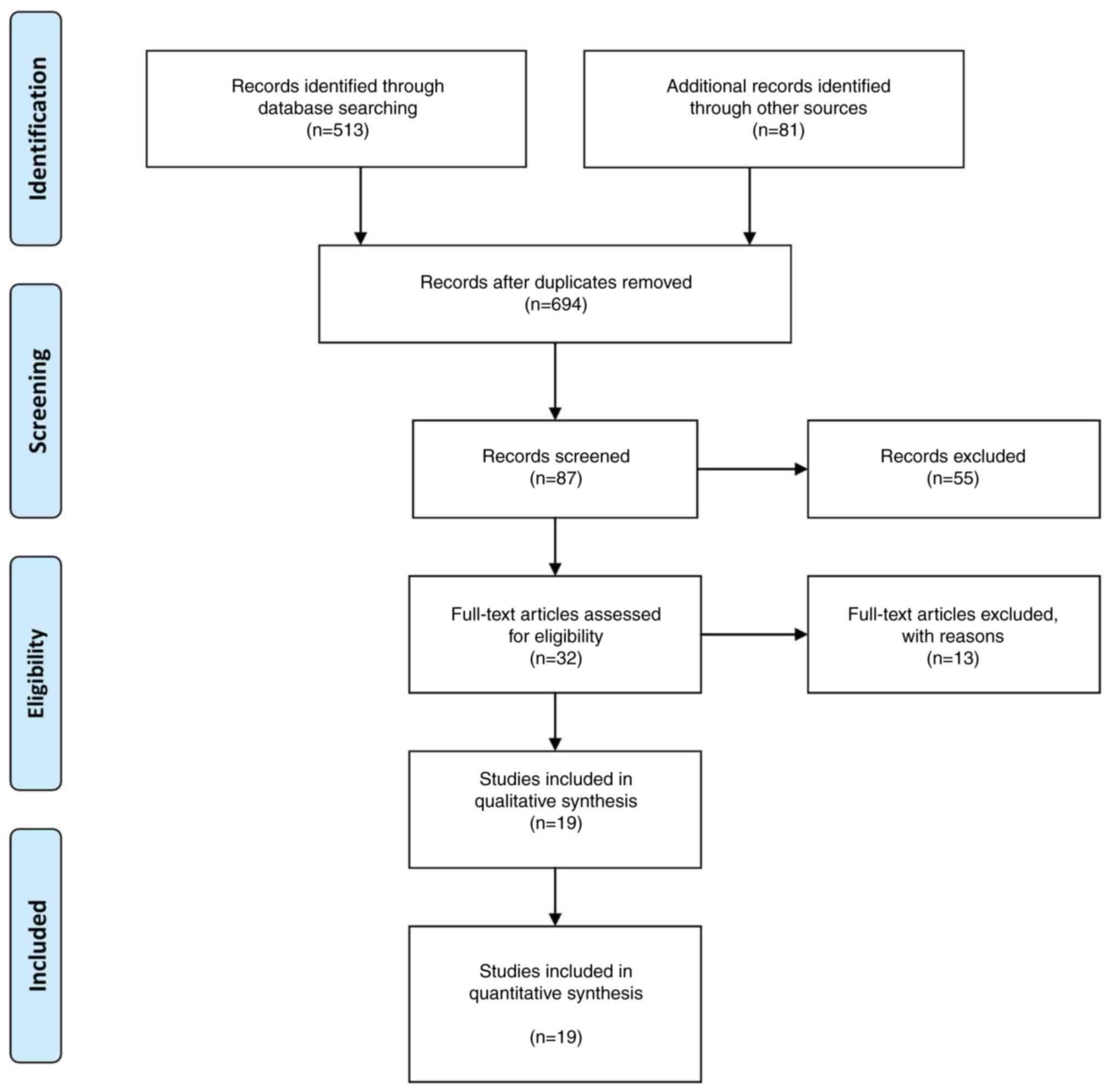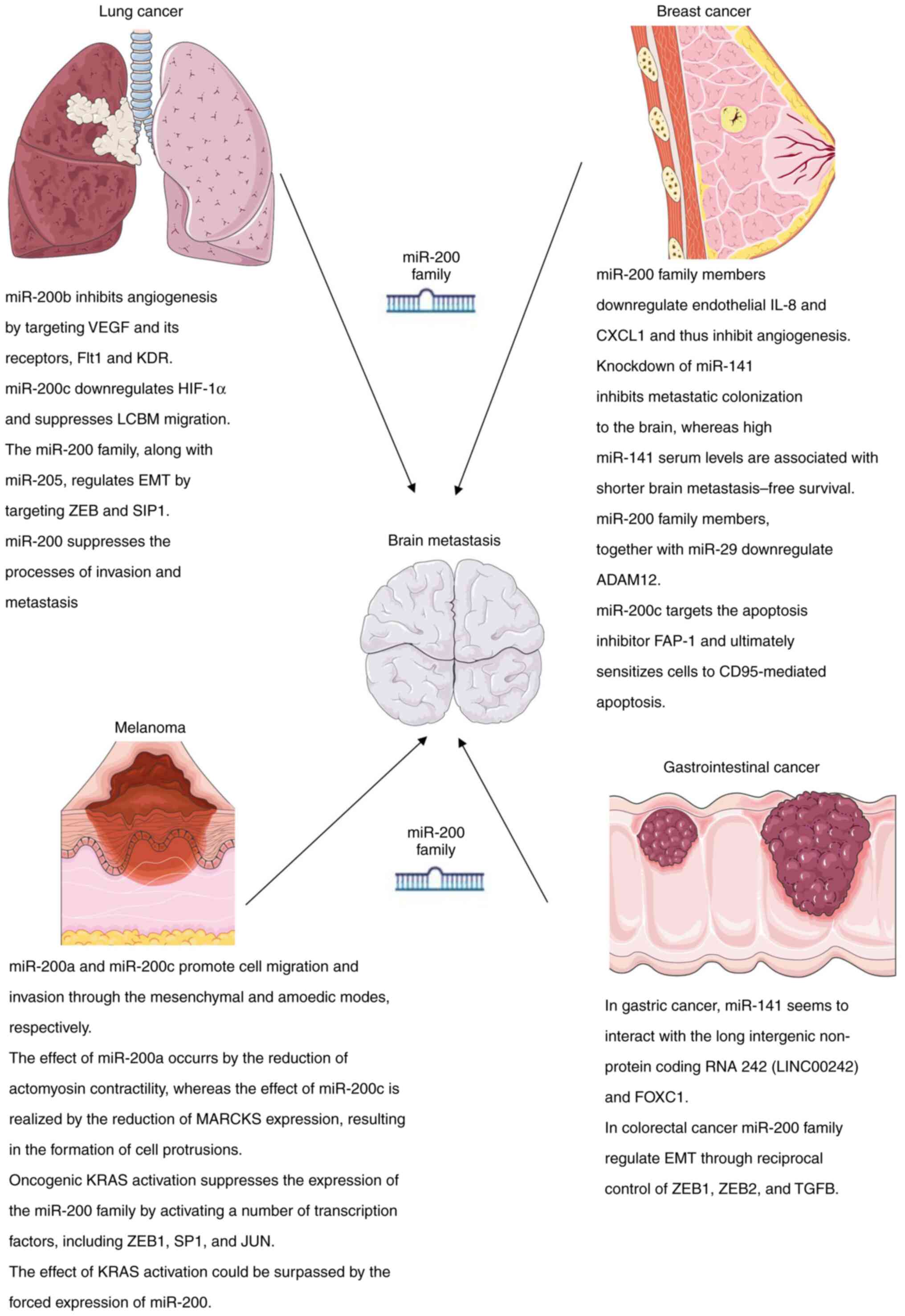|
1
|
Clouston PD, DeAngelis LM and Posner JB:
The spectrum of neurological disease in patients with systemic
cancer. Ann Neurol. 31:268–273. 1992.PubMed/NCBI View Article : Google Scholar
|
|
2
|
Soffietti R, Cornu P, Delattre JY, Grant
R, Graus F, Grisold W, Heimans J, Hildebrand J, Hoskin P, Kalljo M,
et al: EFNS Guidelines on diagnosis and treatment of brain
metastases: Report of an EFNS Task Force. Eur J Neurol. 13:674–681.
2006.PubMed/NCBI View Article : Google Scholar
|
|
3
|
Nussbaum ES, Djalilian HR, Cho KH and Hall
WA: Brain metastases. Histology, multiplicity, surgery, and
survival. Cancer. 78:1781–1788. 1996.PubMed/NCBI
|
|
4
|
Achrol AS, Rennert RC, Anders C, Soffietti
R, Ahluwalia MS, Nayak L, Peters S, Arvold ND, Harsh GR, Steeg PS
and Chang SD: Brain metastases. Nat Rev Dis Primers.
5(5)2019.PubMed/NCBI View Article : Google Scholar
|
|
5
|
Boire A, Brastianos PK, Garzia L and
Valiente M: Brain metastasis. Nat Rev Cancer. 20:4–11.
2020.PubMed/NCBI View Article : Google Scholar
|
|
6
|
Gavrilovic IT and Posner JB: Brain
metastases: Epidemiology and pathophysiology. J Neurooncol.
75:5–14. 2005.PubMed/NCBI View Article : Google Scholar
|
|
7
|
Fidler IJ: The biology of brain
metastasis: Challenges for therapy. Cancer J. 21:284–293.
2015.PubMed/NCBI View Article : Google Scholar
|
|
8
|
Ambros V, Bartel B, Bartel DP, Burge CB,
Carrington JC, Chen X, Dreyfuss G, Eddy SR, Griffiths-Jones S,
Marshall M, et al: A uniform system for microRNA annotation. RNA.
9:277–279. 2003.PubMed/NCBI View Article : Google Scholar
|
|
9
|
Bartel DP: MicroRNAs: Genomics,
biogenesis, mechanism, and function. Cell. 116:281–297.
2004.PubMed/NCBI View Article : Google Scholar
|
|
10
|
Croce CM and Calin GA: miRNAs, cancer, and
stem cell division. Cell. 122:6–7. 2005.PubMed/NCBI View Article : Google Scholar
|
|
11
|
Filipowicz W, Jaskiewicz L, Kolb FA and
Pillai RS: Post-transcriptional gene silencing by siRNAs and
miRNAs. Curr Opin Struct Biol. 15:331–341. 2005.PubMed/NCBI View Article : Google Scholar
|
|
12
|
Sontheimer EJ and Carthew RW: Silence from
within: Endogenous siRNAs and miRNAs. Cell. 122:9–12.
2005.PubMed/NCBI View Article : Google Scholar
|
|
13
|
Barbato S, Solaini G and Fabbri M:
MicroRNAs in oncogenesis and tumor suppression. Int Rev Cell Mol
Biol. 333:229–268. 2017.PubMed/NCBI View Article : Google Scholar
|
|
14
|
Frixa T, Donzelli S and Blandino G:
Oncogenic MicroRNAs: Key players in malignant transformation.
Cancers (Basel). 7:2466–2485. 2015.PubMed/NCBI View Article : Google Scholar
|
|
15
|
Li J, Zhang Z, Chen F, Hu T, Peng W, Gu Q
and Sun Y: The diverse oncogenic and tumor suppressor roles of
microRNA-105 in cancer. Front Oncol. 9(518)2019.PubMed/NCBI View Article : Google Scholar
|
|
16
|
Zhang B, Pan X, Cobb GP and Anderson TA:
microRNAs as oncogenes and tumor suppressors. Dev Biol. 302:1–12.
2007.PubMed/NCBI View Article : Google Scholar
|
|
17
|
Zhou K, Liu M and Cao Y: New Insight into
microRNA functions in cancer: Oncogene-microRNA-Tumor suppressor
gene network. Front Mol Biosci. 4(46)2017.PubMed/NCBI View Article : Google Scholar
|
|
18
|
Koutsaki M, Libra M, Spandidos DA and
Zaravinos A: The miR-200 family in ovarian cancer. Oncotarget.
8:66629–66640. 2017.PubMed/NCBI View Article : Google Scholar
|
|
19
|
Choi YC, Yoon S, Jeong Y, Yoon J and Baek
K: Regulation of vascular endothelial growth factor signaling by
miR-200b. Mol Cells. 32:77–82. 2011.PubMed/NCBI View Article : Google Scholar
|
|
20
|
Huang GL, Sun J, Lu Y, Liu Y, Cao H, Zhang
H and Calin GA: MiR-200 family and cancer: From a meta-analysis
view. Mol Aspects Med. 70:57–71. 2019.PubMed/NCBI View Article : Google Scholar
|
|
21
|
Humphries B and Yang C: The microRNA-200
family: Small molecules with novel roles in cancer development,
progression and therapy. Oncotarget. 6:6472–6498. 2015.PubMed/NCBI View Article : Google Scholar
|
|
22
|
Langley RR and Fidler IJ: The biology of
brain metastasis. Clin Chem. 59:180–189. 2013.PubMed/NCBI View Article : Google Scholar
|
|
23
|
Uhlmann S, Zhang JD, Schwäger A,
Mannsperger H, Riazalhosseini Y, Burmester S, Ward A, Korf U,
Wiemann S and Sahin O: miR-200bc/429 cluster targets PLCgamma1 and
differentially regulates proliferation and EGF-driven invasion than
miR-200a/141 in breast cancer. Oncogene. 29:4297–4306.
2010.PubMed/NCBI View Article : Google Scholar
|
|
24
|
Roybal JD, Zang Y, Ahn YH, Yang Y, Gibbons
DL, Baird BN, Alvarez C, Thilaganathan N, Liu DD, Saintigny P, et
al: miR-200 Inhibits lung adenocarcinoma cell invasion and
metastasis by targeting Flt1/VEGFR1. Mol Cancer Res. 9:25–35.
2011.PubMed/NCBI View Article : Google Scholar
|
|
25
|
Byun Y, Choi YC, Jeong Y, Lee G, Yoon S,
Jeong Y, Yoon J and Baek K: MiR-200c downregulates HIF-1α and
inhibits migration of lung cancer cells. Cell Mol Biol Lett.
24(28)2019.PubMed/NCBI View Article : Google Scholar
|
|
26
|
Gregory PA, Bert AG, Paterson EL, Barry
SC, Tsykin A, Farshid G, Vadas MA, Khew-Goodall Y and Goodall GJ:
The miR-200 family and miR-205 regulate epithelial to mesenchymal
transition by targeting ZEB1 and SIP1. Nat Cell Biol. 10:593–601.
2008.PubMed/NCBI View
Article : Google Scholar
|
|
27
|
Chen L, Gibbons DL, Goswami S, Cortez MA,
Ahn YH, Byers LA, Zhang X, Yi X, Dwyer D, Lin W, et al: Metastasis
is regulated via microRNA-200/ZEB1 axis control of tumour cell
PD-L1 expression and intratumoral immunosuppression. Nat Commun.
5(5241)2014.PubMed/NCBI View Article : Google Scholar
|
|
28
|
Gibbons DL, Lin W, Creighton CJ, Rizvi ZH,
Gregory PA, Goodall GJ, Thilaganathan N, Du L, Zhang Y,
Pertsemlidis A and Kurie JM: Contextual extracellular cues promote
tumor cell EMT and metastasis by regulating miR-200 family
expression. Genes Dev. 23:2140–2151. 2009.PubMed/NCBI View Article : Google Scholar
|
|
29
|
Park SM, Gaur AB, Lengyel E and Peter ME:
The miR-200 family determines the epithelial phenotype of cancer
cells by targeting the E-cadherin repressors ZEB1 and ZEB2. Genes
Dev. 22:894–907. 2008.PubMed/NCBI View Article : Google Scholar
|
|
30
|
Pecot CV, Rupaimoole R, Yang D, Akbani R,
Ivan C, Lu C, Wu S, Han HD, Shah MY, Rodriguez-Aguayo C, et al:
Tumour angiogenesis regulation by the miR-200 family. Nat Commun.
4(2427)2013.PubMed/NCBI View Article : Google Scholar
|
|
31
|
Gravgaard KH, Lyng MB, Laenkholm AV,
Søkilde R, Nielsen BS, Litman T and Ditzel HJ: The miRNA-200 family
and miRNA-9 exhibit differential expression in primary versus
corresponding metastatic tissue in breast cancer. Breast Cancer Res
Treat. 134:207–217. 2012.PubMed/NCBI View Article : Google Scholar
|
|
32
|
Debeb BG, Lacerda L, Anfossi S,
Diagaradjane P, Chu K, Bambhroliya A, Huo L, Wei C, Larson RA,
Wolfe AR, et al: miR-141-Mediated regulation of brain metastasis
from breast cancer. J Natl Cancer Inst. 108(djw026)2016.PubMed/NCBI View Article : Google Scholar
|
|
33
|
Duhachek-Muggy S and Zolkiewska A:
ADAM12-L is a direct target of the miR-29 and miR-200 families in
breast cancer. BMC Cancer. 15(93)2015.PubMed/NCBI View Article : Google Scholar
|
|
34
|
Shao B, Wang X, Zhang L, Li D, Liu X, Song
G, Cao H, Zhu J and Li H: Plasma microRNAs predict chemoresistance
in patients with metastatic breast cancer. Technol Cancer Res
Treat. 18(1533033819828709)2019.PubMed/NCBI View Article : Google Scholar
|
|
35
|
Schickel R, Park SM, Murmann AE and Peter
ME: miR-200c regulates induction of apoptosis through CD95 by
targeting FAP-1. Mol Cell. 38:908–915. 2010.PubMed/NCBI View Article : Google Scholar
|
|
36
|
Mueller DW, Rehli M and Bosserhoff AK:
miRNA expression profiling in melanocytes and melanoma cell lines
reveals miRNAs associated with formation and progression of
malignant melanoma. J Invest Dermatol. 129:1740–1751.
2009.PubMed/NCBI View Article : Google Scholar
|
|
37
|
Rosenfeld N, Aharonov R, Meiri E,
Rosenwald S, Spector Y, Zepeniuk M, Benjamin H, Shabes N, Tabak S,
Levy A, et al: MicroRNAs accurately identify cancer tissue origin.
Nat Biotechnol. 26:462–469. 2008.PubMed/NCBI View
Article : Google Scholar
|
|
38
|
Elson-Schwab I, Lorentzen A and Marshall
CJ: MicroRNA-200 family members differentially regulate
morphological plasticity and mode of melanoma cell invasion. PLoS
One. 5(e13176)2010.PubMed/NCBI View Article : Google Scholar
|
|
39
|
Zhong X, Zheng L, Shen J, Zhang D, Xiong
M, Zhang Y, He X, Tanyi JL, Yang F, Montone KT, et al: Suppression
of MicroRNA 200 family expression by oncogenic KRAS Activation
promotes cell survival and epithelial-mesenchymal transition in
KRAS-Driven cancer. Mol Cell Biol. 36:2742–2754. 2016.PubMed/NCBI View Article : Google Scholar
|
|
40
|
Zhong X, Yu X, Wen X, Chen L and Gu N:
Activation of the LINC00242/miR-141/FOXC1 axis underpins the
development of gastric cancer. Cancer Cell Int.
20(272)2020.PubMed/NCBI View Article : Google Scholar
|
|
41
|
Youn YH, Byun HJ, Yoon JH, Park CH and Lee
SK: Long Noncoding RNA N-BLR upregulates the migration and invasion
of gastric adenocarcinoma. Gut Liver. 13:421–429. 2019.PubMed/NCBI View Article : Google Scholar
|
|
42
|
Kanchan RK, Siddiqui JA, Mahapatra S,
Batra SK and Nasser MW: microRNAs orchestrate pathophysiology of
breast cancer brain metastasis: Advances in therapy. Mol Cancer.
19(29)2020.PubMed/NCBI View Article : Google Scholar
|
|
43
|
Balachandran AA, Larcher LM, Chen S and
Veedu RN: Therapeutically significant MicroRNAs in primary and
metastatic brain malignancies. Cancers (Basel).
12(2534)2020.PubMed/NCBI View Article : Google Scholar
|
|
44
|
Ahn YH and Ko YH: Diagnostic and
therapeutic implications of microRNAs in non-small cell lung
cancer. Int J Mol Sci. 21(8782)2020.PubMed/NCBI View Article : Google Scholar
|
|
45
|
Peng L, Fu J and Ming Y: The miR-200
family: Multiple effects on gliomas. Cancer Manag Res.
10:1987–1992. 2018.PubMed/NCBI View Article : Google Scholar
|
|
46
|
Teplyuk NM, Mollenhauer B, Gabriely G,
Giese A, Kim E, Smolsky M, Kim RY, Saria MG, Pastorino S, Kesari S
and Krichevsky AM: MicroRNAs in cerebrospinal fluid identify
glioblastoma and metastatic brain cancers and reflect disease
activity. Neuro Oncol. 14:689–700. 2012.PubMed/NCBI View Article : Google Scholar
|
|
47
|
Venneti S, Boateng LA, Friedman JR,
Baldwin DA, Tobias JW, Judkins AR, Mourelatos Z and Lal P: MiRNA-9
and MiRNA-200a distinguish hemangioblastomas from metastatic clear
cell renal cell carcinomas in the CNS. Brain Pathol. 22:522–529.
2012.PubMed/NCBI View Article : Google Scholar
|
|
48
|
Minn YK, Lee DH, Hyung WJ, Kim JE, Choi J,
Yang SH, Song H, Lim BJ and Kim SH: MicroRNA-200 family members and
ZEB2 are associated with brain metastasis in gastric
adenocarcinoma. Int J Oncol. 45:2403–2410. 2014.PubMed/NCBI View Article : Google Scholar
|
|
49
|
Maierthaler M, Benner A, Hoffmeister M,
Surowy H, Jansen L, Knebel P, Chang-Claude J, Brenner H and
Burwinkel B: Plasma miR-122 and miR-200 family are prognostic
markers in colorectal cancer. Int J Cancer. 140:176–187.
2017.PubMed/NCBI View Article : Google Scholar
|
|
50
|
Yu C, Wan H, Shan R, Wen W, Li J, Luo D
and Wan R: The prognostic value of the MiR-200 family in colorectal
cancer: A meta-analysis with 1882 patients. J Cancer. 10:4009–4016.
2019.PubMed/NCBI View Article : Google Scholar
|
|
51
|
Fu J, Rodova M, Nanta R, Meeker D, Van
Veldhuizen PJ, Srivastava RK and Shankar S: NPV-LDE-225
(Erismodegib) inhibits epithelial mesenchymal transition and
self-renewal of glioblastoma initiating cells by regulating miR-21,
miR-128, and miR-200. Neuro Oncol. 15:691–706. 2013.PubMed/NCBI View Article : Google Scholar
|
















